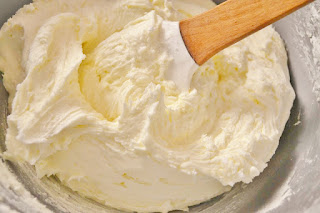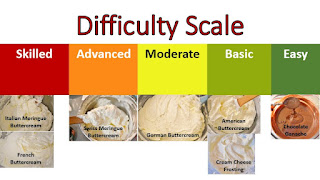Baking Basics: Differences Between Buttercreams
When I was posting the recipe for French buttercream, I realized how confusing it can sound because all the buttercream recipes seemed to be tied to a place and are not clear from the names what the differences are between them.
Let’s start with a classic: American buttercream.
This one is the standard buttercream in several countries, including the US and the UK. It’s very easy to make vegan and it is easy to make variations. Basically, you mix your fat (butter, shortening or margarine) with lots of powdered sugar and thin it down with water, milk or some other liquid.
I also have variations on the classic recipe on my channel for a cinnamon version, a lemon version, a peanut butter version and a strawberry version.
American buttercream is stable under fondant.
However, on a scale of not sweet to sickeningly sweet, it is sickeningly sweet. So, you will only enjoy this buttercream if you love things that are very, very sweet.
On the plus side, you really only need some basic baking experience to make it. It’s very easy to make. The only thing that can go wrong is if you add too much liquid, so add liquid a tablespoon at a time. Don’t go overboard.Moving on to my personal favorite: Swiss Meringue Buttercream.
This one is a favorite among cake decorators. It is made with lots of egg whites, granulated sugar and butter.
I also have a lemon version on my channel, as well as a raspberry version, and a strawberry version. The technique is to heat the egg whites and sugar over a double boiler until all the sugar has dissolved and the mixture feels hot to the touch, beat the hot mixture until it cools to room temperature and forms a white, glossy meringue.
Then slowly beat in the butter and continue to beat until mixture reaches buttercream consistency.
This one is also stable under fondant. In fact, if anything, it is more stable than American buttercream. It sets up beautifully.
I would put this one at moderately sweet. You can also add more or less sugar a bit, depending on your taste.
However, I would put this one at advanced on the difficulty scale. You do need to know what you’re doing in the kitchen to make this one. If you’re inexperienced, it might not turn out. In fact, a lot of people hate making this one because the first attempt or two did not work out. Either got too hot on the stove, or melted the butter or didn’t set up properly. And a lot of people hate this one simply because of the difficulty level.
Let’s move on to Italian Meringue Buttercream.
This one is very similar to Swiss Meringue Buttercream and except of the addition of a bit of water, has EXACTLY the same ingredients. Lots of egg whites, granulated sugar and butter.
It’s the technique that’s different. You start out by boiling the water and sugar together to form a sugar syrup.
Then whip your egg whites to at least soft peaks and slowly pour the hot syrup into the egg whites.
From this point, it’s just like Swiss meringue. Allow the mixture to cool by beating it to a meringue. Slowly beat in butter and continue to beat until mixture achieves buttercream consistency. It behaves and tastes almost identical to Swiss meringue buttercream because the ingredients are so similar.
So, yes, stable under fondant and moderately sweet. It is harder to use less sugar, though, because then the sugar syrup might not be at the right consistency.
That extra complication pushes this one up a level in difficulty to skilled. If you can make Italian Meringue Buttercream, you definitely know what you’re doing. Not at all recommended for beginners, though. And you must have a stand mixer or you could burn yourself on the sugar syrup.
Making our way through Europe, let’s move on to German Buttercream.
This one has quite a few more ingredients than most because German buttercream is custard-based.
So, you first make a thick custard and allow it to come to room temperature.
Then cream your room-temperature butter and slowly beat in the custard. Everything must be at the same temperature or it won’t come together properly.
Unfortunately, because of the high water content with the added milk, this one is not stable under fondant. This will melt your fondant. However, it is pipeable. So, if you wanted to make a buttercream cake it would be a good choice.
And of all options, it is one of the least sweet buttercreams there is.
And, because of the temperature difficulty, I would put this at moderate difficulty.
And, our last actual buttercream of the day, is French Buttercream.
This one is very similar to Italian Meringue Buttercream, except instead of using the egg whites, you use the egg yolks. Also, the recipe I have uses cream of tartar to stabilize the egg yolks and also uses less sugar than the Italian Meringue recipe.
However, the technique is practically identical. Boil your sugar syrup, beat egg yolks, pour hot syrup into the egg yolk mixture, beat mixture until it becomes white and ribbons (it will not be as stiff as a meringue) and slowly beat in the butter until it gets to buttercream consistency.
It is stable under fondant and is down there with German buttercream in sweetness, as it is not very sweet.
However, being so similar in method to Italian Meringue Buttercream, it is also the same difficulty level.
Let’s now look at a few other frostings that aren’t necessarily buttercream but can also be used to frost a cake. What about chocolate ganache?
Ganache is very simple and only requires two ingredients: chocolate and cream. The ratios change a bit depending on the kind of chocolate: dark, milk or white.
But with so few ingredients, it tastes basically exactly like the chocolate you choose. It is incredibly stable under fondant. In fact, of those on the list so far, ganache is probably the most stable.
Since there is no added sugar to the recipe, the ganache itself is exactly as sweet as the chocolate you choose. So, if you choose a very bitter dark chocolate, it won’t be sweet at all. If you choose a white chocolate, however, it might be quite sweet. So, it all depends on your choice of chocolate.
However, this recipe is probably easily the easiest recipe on this list. I would let my children make this because it’s that easy. It doesn’t require a stove. I make mine in the microwave. It also only takes about three minutes to make. However, it does need to set up a bit before using it, so I recommend making it ahead of time.
Let’s talk about cream cheese frosting.
Lots of people love this one for the tangy taste. It’s a bit of a variant of American buttercream with cream cheese thrown in there. Watch the amount of water in the cream cheese, though. You’ll want to look for full fat cream cheese. Don’t even think about light cream cheese, because it won’t thicken to frosting consistency and will just stay liquidy.
Now, whether or not you can use this one under fondant entirely depends on your recipe. The standard cream cheese frosting recipe is not stable enough under fondant and has too high of a water content. However, the adapted recipe I have up on the channel can be okay under fondant as long as it’s chilled very well. So, this one I will put on the fence.
Being a variation of the American buttercream, though, it is very sweet. Not quite as sweet as the classic, but close. And difficulty level similar to American buttercream, just basic.
Let’s talk royal icing.
This is not one I would use to frost a cake, but it is one I would use to pipe decorations with or would frost cookies with. So, it can’t be used as a buttercream. Only a couple ingredients, really. The main ingredients are egg whites and powdered sugar.
However, all you can really taste is the powdered sugar, so I’m putting it at the sickeningly sweet level.
But difficulty level is easy. I’m not looking at stability under fondant because you could not frost a cake with this. So, it’s really not a question.
And, last one I’m going to talk about today, stabilized whipped cream.
I have used this as a frosting a couple of times. It can work, although it is very soft, so it can be challenging to frost. Main ingredients are whipping cream and powdered sugar.
Because of the high water content of the cream, though, it is not stable under fondant. Honestly, it is so soft, it probably wouldn’t be anyway. Try to put fondant on top of whipped cream and it will just slide right off the cake.
It is not too sweet, as there is a lot more whipping cream than powdered sugar.
However, because of the danger of overbeating the cream, I would put it at moderate difficulty.
I hope this information was helpful for you to choose just the right buttercream or frosting recipe for your project. Leave me a comment on what your favorite frosting is. Did I miss one you wished had been on the list?
Watch us talk about the different kinds of buttercream and frosting on our YouTube channel here: https://youtu.be/CqiADWjw010
Schaut zu wie wir über die verschiedene Buttercremes und Verzierungen auf unserem YouTube Kanal reden hier: https://youtu.be/Ur_9M-Cm-hg








































.JPG)
.JPG)
.JPG)
.JPG)
.JPG)
.JPG)


























Comments
Post a Comment